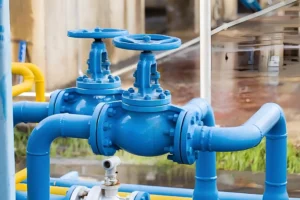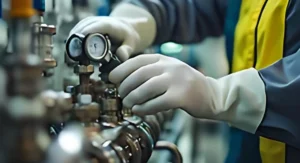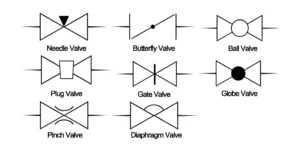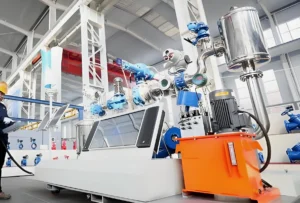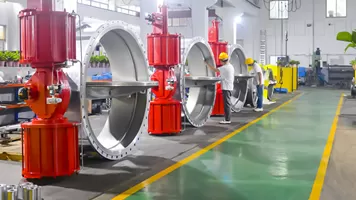Brief introduction
Butterfly valve, also known as flap valve, is a type of regulating valve with a simple structure that can be used for on/off control of low-pressure pipeline media. Butterfly valve refers to a valve whose closing element (valve disc or butterfly plate) is a disc that rotates around the valve axis to achieve opening and closing.
Valves can be used to control the flow of various types of fluids such as air, water, steam, various corrosive media, mud, oil, liquid metals, and radioactive media. It mainly plays a role in cutting off and throttling on pipelines. The butterfly valve opening and closing component is a disc-shaped butterfly plate that rotates around its own axis inside the valve body to achieve the purpose of opening, closing, or adjusting.
Working principle of industrial butterfly valve:
When it is necessary to open the butterfly valve, rotate the valve stem by operating the transmission device (such as handle, electric device, etc.). The rotation of the valve stem drives the butterfly plate to rotate around its axis, gradually opening the valve body passage. As the rotation angle of the butterfly plate increases, the medium flow area gradually increases until the butterfly plate rotates to the 90 ° position, and the butterfly valve is in a fully open state. When the butterfly valve is fully open, it has a smaller flow resistance. At this point, the medium can flow smoothly through the valve. When opened between approximately 15 °~70 °, it can also perform sensitive flow control, so butterfly valves are widely used in the field of large-diameter regulation.
Due to the wiping nature of the butterfly valve disc movement, most butterfly valves can be used for media with suspended solid particles. Depending on the strength of the seal, it can also be used for powder and granular media.
Butterfly valves are suitable for flow regulation. Due to the significant pressure loss of butterfly valves in pipelines, which is about three times that of gate valves, when selecting butterfly valves, the impact of pressure loss on the pipeline system should be fully considered, as well as the strength of the butterfly plate to withstand the pressure of the pipeline medium when closed. In addition, it is necessary to consider the limitations of the working temperature that the elastic valve seat material can withstand at high temperatures.
The structure length and overall height of butterfly valves are relatively small, with fast opening and closing speeds and good fluid control characteristics. The structural principle of butterfly valves is most suitable for making large-diameter valves. When a butterfly valve is required for controlling flow, the most important thing is to choose the correct specifications and types of butterfly valves so that they can work properly and effectively.
Usually, in throttling, regulating control, and mud media, short structural length, fast opening and closing speed, and low pressure cutoff (small pressure difference) are required, and butterfly valves are recommended. Butterfly valves can be used for channels with dual position adjustment, reduced diameter, low noise, air pockets and vaporization, small leakage to the atmosphere, and abrasive media. Under special operating conditions such as throttling regulation, strict sealing, severe wear, and low temperature (cryogenic) requirements.
Structure:
Mainly composed of valve body, valve stem, butterfly plate, and sealing ring. The valve body is cylindrical in shape, with a short axial length and a built-in butterfly plate.
Characteristic:
1. Butterfly valves have the characteristics of simple structure, small volume, light weight, low material consumption, small installation size, fast opening and closing, 90 ° reciprocating rotation, and small driving torque. They are used to cut off, connect, and regulate the medium in pipelines, and have good fluid control characteristics and closing sealing performance.
2. Butterfly valves can transport mud and accumulate the least amount of liquid at the pipeline outlet. Under low pressure, good sealing can be achieved. Good regulation performance.
3. The streamlined design of the butterfly plate reduces fluid resistance loss, making it an energy-saving product.
4. The valve stem is a through stem structure that has undergone quenching and tempering treatment, and has good comprehensive mechanical properties, corrosion resistance, and abrasion resistance. When the butterfly valve is opened and closed, the valve stem only rotates and does not move up or down. The packing of the valve stem is not easily damaged and the seal is reliable. Fixed with the butterfly plate cone pin, the extended end is designed to prevent the valve stem from bursting out in case of accidental breakage at the connection between the valve stem and the butterfly plate.
5. The connection methods include flange connection, clamp connection, butt welding connection, and lug clamp connection.
The driving forms include manual, worm gear transmission, electric, pneumatic, hydraulic, electro-hydraulic linkage and other actuating mechanisms, which can achieve remote control and automated operation.
Industrial butterfly valves are mainly classified as follows:
Divided by driving mode
Electric butterfly valve, pneumatic butterfly valve, hydraulic butterfly valve, manual butterfly valve
Divided by structural form:
Center sealed butterfly valve, single eccentric sealed butterfly valve, double eccentric sealed butterfly valve, triple eccentric sealed butterfly valve
Sealing surface materials are divided into:
Soft sealed butterfly valves and sealing pairs are composed of non-metallic soft materials to non-metallic soft materials, and sealing pairs are composed of metallic hard materials to non-metallic soft materials. Metal hard sealed butterfly valves and sealing pairs are composed of metal hard materials.
Industrial butterfly valve usage:
Select
The butterfly plate of the butterfly valve is installed in the diameter direction of the pipeline. Butterfly valves have a simple structure, small size, and light weight, consisting of only a few parts. They can be quickly opened and closed by rotating 90 °, making operation simple. At the same time, the valve has good fluid control characteristics. When the butterfly valve is in the fully open position, the thickness of the butterfly plate is the resistance of the medium flowing through the valve body, so the pressure drop generated by this valve is very small, which has good flow control characteristics.
If butterfly valves are required for flow control, the main thing is to choose the correct size and type of valve. The structural principle of butterfly valves is particularly suitable for making large-diameter valves. There are two commonly used butterfly valves: clamp type butterfly valve and flange type butterfly valve. The clamp type butterfly valve is connected between two pipeline flanges with double headed bolts. The flange type butterfly valve has a flange on the valve, and the flanges on both ends of the valve are connected to the pipeline flange with bolts during use.
Butterfly valves, as a component used to achieve on/off and flow control in pipeline systems, have been widely used in many fields such as petroleum, chemical, metallurgy, hydropower, etc. In the known butterfly valve technology, the sealing form often adopts a sealing structure, and the sealing material is rubber, polytetrafluoroethylene, etc. Due to structural limitations, it is not suitable for industries that are resistant to high temperatures, high pressures, corrosion, and wear.
A relatively advanced butterfly valve is the three eccentric metal hard seal butterfly valve, where the valve body and valve seat are connected components, and the sealing surface layer of the valve seat is welded with heat-resistant and corrosion-resistant alloy materials. The multi-layer soft stacked sealing ring is fixed on the valve plate. Compared with traditional butterfly valves, this butterfly valve has the advantages of high temperature resistance, easy operation, frictionless opening and closing, and compensating for the sealing with the increase of torque of the transmission mechanism when closing, improving the sealing performance and extending the service life of the butterfly valve.
However, this butterfly valve still has the following issues during use:
1. Due to the multi-layer soft and hard stacked sealing ring fixed on the valve plate, when the valve plate is in a normally open state, the medium forms a positive flushing on its sealing surface. The soft sealing tape in the metal sheet interlayer is directly affected by the flushing, which directly affects the sealing performance.
2. Due to structural limitations, this structure is not suitable for valves with diameters below DN200, as the overall structure of the valve plate is too thick and has high flow resistance.
3. Due to the principle of the three eccentric structure, the sealing between the sealing surface of the valve plate and the valve seat is achieved by the torque of the transmission device, which presses the valve plate against the valve seat. In the positive flow state, the higher the medium pressure, the tighter the sealing compression. When the medium in the flow channel flows backwards and the unit positive pressure between the valve plate and the valve seat is less than the medium pressure as the medium pressure increases, the seal begins to leak.
The high-performance tri eccentric bi-directional hard sealed butterfly valve is characterized in that the valve seat sealing ring is composed of multiple layers of stainless steel sheets on both sides of a soft T-shaped sealing ring. The sealing surface between the valve plate and the valve seat is a slanted cone structure, and a heat-resistant and corrosion-resistant alloy material is welded on the slanted cone surface of the valve plate; The structure in which the spring fixed between the adjusting ring pressure plate and the adjusting bolt on the pressure plate are assembled together.
This structure effectively compensates for the tolerance zone between the shaft sleeve and the valve body, as well as the elastic deformation of the valve stem under medium pressure, solving the sealing problem of the valve in the bi-directional exchange of medium transportation process. The sealing ring is composed of multiple layers of stainless steel sheets on both sides of a soft T-shaped structure, which has the dual advantages of metal hard sealing and soft sealing. It has zero leakage sealing performance in both low and high temperature conditions.
Industrial butterfly valves are suitable for:
Water supply and drainage system: used to control the flow and pressure of water, such as urban water supply, sewage treatment, etc.
Petrochemical industry: suitable for transporting various corrosive and flammable/explosive media, such as crude oil, natural gas, chemical raw materials, etc.
Power industry: used to control the flow of media such as steam and water, such as pipeline systems for power plant boilers, steam turbines, and other equipment.
Metallurgical industry: used to control the circulation of various fluid media in the production processes of steel, non-ferrous metals, etc.
Food and pharmaceutical industry: Due to its excellent sealing and hygiene performance, butterfly valves are suitable for fluid control in production processes such as food and pharmaceuticals.


